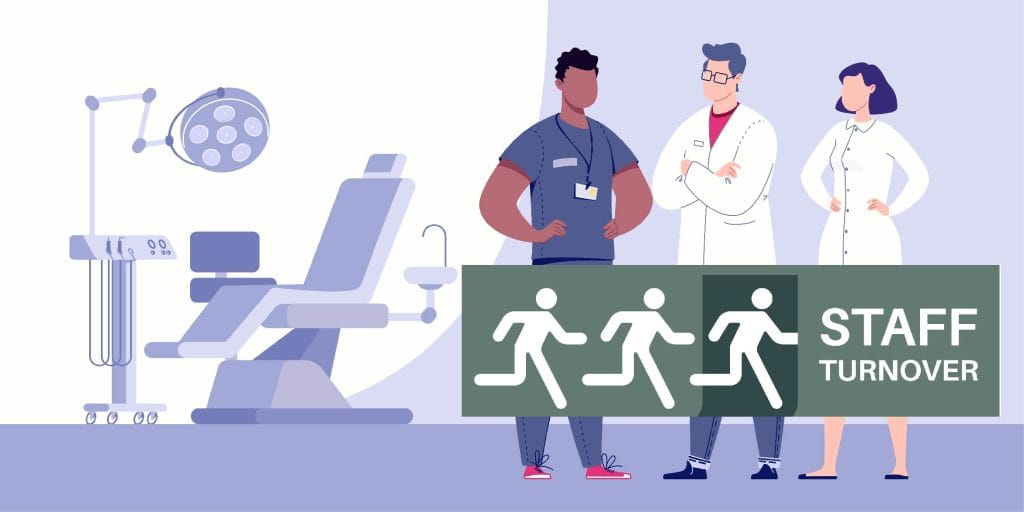Last updated on September 23rd, 2024 at 10:07 pm
 Q: What can I do to get better control of my overhead right now? Losing two months of production has put a big strain on the practice financially.
Q: What can I do to get better control of my overhead right now? Losing two months of production has put a big strain on the practice financially.
Thank you for your question. And yes, you are not alone with this problem!
While overhead control was important in the past, it is more crucial than ever now. That said, the reasons for an “out of control” overhead in a dental practice are not always obvious.
Gaining control starts off with establishing what your overhead actually is in the post COVID-19 environment. So as the first order of business, I’d recommend you get a copy of the dental overhead worksheet and fill it out as accurately as possible. You can download a copy here. We also have a handout which provides overhead percentages by category, so you can see how your office compares. You can also find that here.
Establishing your overhead isn’t a matter of just printing off P&Ls and such. In many cases, especially with fixed expenses (rent, lease payments, etc.), these numbers are already known. And payroll is a simple thing to calculate – some employees are paid a salary and some are hourly. Sit with your office manager and work out how much each hourly employee is paid, their average weekly hours and calculate.
And remember with weekly expenses, you don’t just multiply by “four” to get the monthly expense. It will give you an inaccurate figure. If you multiply 4 X 12 = 48 weeks, but there are 52 weeks in a year. So for weekly expenses – multiply by 52 (weeks in a year) and divide by 12 to get the monthly sum. Not that big of a difference – but it adds up if you make this mistake a few times!
P&Ls are helpful with variable expenses, but again I warn you, what if you’ve been spending TOO much in a category – i.e. Office Supplies? You’ve bought enough to last you a year. You don’t need that much. So, looking at your P&L, (which is a record of what was spent), doesn’t tell you what you SHOULD be spending. If $1,000 a month leaves you more than you’d ever you – maybe you should be spending $600 or $750 a month. So, yes – have your P&L handy – but don’t just blindly fill out the numbers. Look at it in more detail.

P&Ls are helpful with variable expenses, but again I warn you, what if you’ve been spending TOO much in a category – i.e. Office Supplies? You’ve bought enough to last you a year. You don’t need that much. So, looking at your P&L, (which is a record of what was spent), doesn’t tell you what you SHOULD be spending. If $1,000 a month leaves you more than you’d ever you – maybe you should be spending $600 or $750 a month. So, yes – have your P&L handy – but don’t just blindly fill out the numbers. Look at it in more detail.
Also, make sure you read the Overhead Sheet thoroughly before you start – instructions are all there – including what I covered above.
(Related: 10 Tips for Scheduling Patients As Your Practice Re-Opens)
An Extra Step
You’ll want to take an extra step as you go through all of this. Especially now where we are trying to shave anything that we don’t need to spend.
I’d pull my credit card statements and checkbook register for the past four months. Look at each expenditure. Chances are you’ve been spending money (possibly on a recurring monthly basis) that you really don’t need to be spending right now. In other words, your practice would function just fine without it.
Expenses like this would be cut. Stop spending it. And ensure it’s not included in your overhead figure when you calculate.
And don’t forget to adjust overhead categories where spending may have changed – i.e. you may need more for supplies with added PPE costs and so on.
After you have established your overhead, take a look at your average collections and what you would expect them to be in the coming months. Be conservative. Adjust your overhead so that it fits within your projected income. With the tax deadline pushed, you may have spent some of the tax money you had saved for April. Or put off paying paying certain bills. This all needs to be caught up. If so, figure out by when and add this monthly amount to your overhead.
Last point, don’t get too heavy handed with cutting down your overhead. You obviously need to spend on supplies, lab, rent, staff payroll, insurances, and the like. There are also few other important categories to keep in there that you may not have considered.
(Related: 4 Profitability Killers in a Dental Practice)
Catching Up
 Ultimately, making up for lost production and increasing revenues will be achieved by two things:
Ultimately, making up for lost production and increasing revenues will be achieved by two things:
- Increased staff competence. Every action MUST “count” right now, and your team needs to be working together efficiently to pull of high levels of productivity in the face of all the new challenges. Payroll mainly becomes a problem if your team is underproducing—and the answer to that is training your team so they can become more competent and productive on their jobs.
- New Patient Marketing: If you had been doing successful marketing prior to COVID-19, then get it going again! The key word being SUCCESSFUL – i..e was it working! If it was maybe even do more than before. You’re going to need more new patients than ever. If you didn’t have any marketing going – now is the time to fix that.
I wouldn’t cut team training or marketing out of the budget right now, even though it may be tempting to do so. I consider them essential for practice growth and increasing revenues.
With overhead control such a hot issue right now, we have two solutions:
- If you’re not already an MGE client – you can attend a free virtual workshop on the subject, The Profitability & Overhead Control Workshop. This is part of our “Practice Recovery Program” consisting of 6 workshops on crucial topics for getting your practice quickly productive and profitable again in the aftermath of COVID-19. I highly recommend attending those workshops.
- If you are an MGE client, contact your Power Client Manager or our Director of Practical Application, Chris Menkhaus (chrism@mgeonline.com), or me sabrib@mgeonline.com for one-on-one help!
Otherwise, if you need help or have questions about this point, feel free to contact me at SabriB@mgeonline.com
Q: We’ve spoken to several patients that don’t want to schedule right now due to concerns about COVID-19. How would you handle something like this?
Obviously, I am not an infectious diseases specialist or a doctor of any kind, so I can’t dispense health care advice! In my opinion, worries about contracting COVID-19 are a valid concern for many people. That said, it doesn’t mean that these people don’t need dental care anymore. To that end, it could be more important than ever now to take care of yourself, stay healthy, handle any active infections and keep an eye on things.

If a patient expresses a concern such as you’ve mentioned, the first thing I would do is find out why. Are they at-risk? Living with someone that’s at-risk? Find out what’s going on.
This should be a friendly conversation. I wouldn’t push them to schedule but find out what concerns they have.
And let’s be real, this was an unprecedented situation – and the media didn’t help. It’s not shocking that some people are scared out of their wits! Even if they are not considered high risk for adverse effects.
You can’t guarantee that when they leave their house and come to your office that they won’t contract COVID-19. They could contract it at the grocery store for that matter. After speaking with them, if you find no obvious reason (i.e. not at risk, etc.) why they’re scared, simply explaining the infection control protocols you have in place may be enough to allay their fears. Again, I wouldn’t try to “convince them.” I’d just explain.
Some patient might schedule at this point. Some will still have concerns. And that’s okay. We don’t want to browbeat anyone into coming into the office at times like this.
If they aren’t comfortable about coming into the office—this is important—make sure you get them scheduled for some time in the future before you hang up the phone! They are not comfortable coming in now. OK. Well, find out when they would be comfortable coming in. They tell you three months from now. All right, schedule them for three months from now! What you do not want is a bunch of unscheduled patients “falling through the cracks” and not being followed up. Get them on the book – even if it’s months away!
Now, I say all this, and I can guarantee you there will be the occasional patient who can or will not give you a date when they would feel comfortable coming back. That is OK too. I would not push it. It is going to be a small percentage that fall into this category – just make sure you follow up with them. You might set up to call them in a month and see how things are going and has anything changed? Maybe the news is better and they feel ready to come back.
I hope these answers help! And if you have any other questions for me, email me any time at SabriB@mgeonline.com.
If you’d like more direct help, call us at (800) 640-1140 and schedule a free consultation with an MGE specialist. We’d be happy to speak with you.
Q: We just reopened but I have a few staff that either can’t or aren’t willing to come back to work yet. What options do I have?
In the post-COVID19 world, staffing is a huge issue. And we’ve had a number of clients that had to reopen understaffed. You may have staff that can’t come back to work because they’re at-risk, have kids at home, etc. Or, they don’t want to come back to work because they’re scared—or (and yes we’ve heard this) because they’re making more money from unemployment.
Now, I am not an employment attorney. And depending on your situation, this is one of those cases where I’d suggest you have a good employment attorney on speed dial. For that matter, as a business owner, having a relationship with an employment attorney is always a good thing. You could spend a couple thousand now to potentially save a lot more down the road.
Obviously, the first thing I’d do if an employee could or would not return is find out why? It might be a simple fix. For example, we had a client who’s employees expressed concerns about coming back, and the doctor listened to them and gave them a tour of the office prior to reopening showing them all the new protocols that were in place. Like your patients, these last few months have been rough on them too and they may not know what to think about all of this. Long story short, these employees saw what the doctor had in place and decided that they wanted to come back to work – with no further urging on the doctor’s part. Easy fix.
Not all situations are going to be that easy though.
If I had a good employee that was at home with kids, and would like to come back to work, I could probably make do for a few weeks until childcare or summer programs were back open and whatnot. It makes things a little tougher for a time, but good employees are one of the most valuable assets your practice has.
So, first thing – find out what’s going on. Just get the data – no judging.
Now, I’ve intentionally stuck with the “easier” answers in this section, because again – every situation is different and… I’m not an employment attorney!
That said, Devora Lindeman, an employment attorney that has helped many of our clients, wrote a wonderful article about this very subject (employees who can’t or won’t return to work) for one of our seminars, and it’s also available on our blog – you can read it here. It covers most of the scenarios you may run into and, unlike a lot of legal articles, it’s a good and interesting read! It isn’t legal advice, so I still would recommend working with an employment attorney in your area and doing everything by the book. But check it out, it definitely helps.
Now, if you do end up with team members that will not be coming back, you’ll have to hire and onboard quickly. Teaching our clients how to do this is one of our specialties. If you’re not an MGE client, we have a free virtual workshop that goes over all of this called the How to Find and Hire Quality Staff Quickly Workshop. You can register for one of our upcoming dates here. If you are currently an MGE client, contact your Power Client Manager or our Director of Practical Application, Chris Menkhaus (ChrisM@mgeonline.com), or me SabriB@mgeonline.com for one-on-one help!
Hope all this helps! I wish you the best and again, if you need anything at all, you can contact us at (800) 640-1140.




No Comments
Be the first to start a conversation